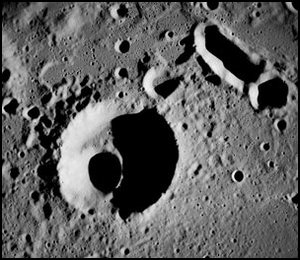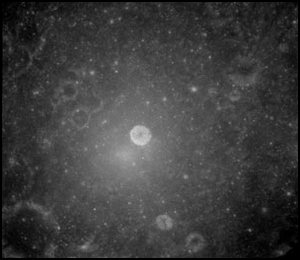-
 Mike Collins (CAPCOM)
Mike Collins (CAPCOM)
-
People listening to the high bit rate down here say it's like sitting in your living room listening to good hi-fi.
-
 Mike Collins (CAPCOM)
Mike Collins (CAPCOM)
-
Apollo 8, Houston. Coming up on 2 minutes to LOS. We got a good reservice on the primary evaporator, and everything is still looking very good down here.
-
 Mike Collins (CAPCOM)
Mike Collins (CAPCOM)
-
Apollo 8, Houston. One minute to LOS. Are you still reading us loud and clear?
-
 Mike Collins (CAPCOM)
Mike Collins (CAPCOM)
-
Okay, fine. We've been noticing a little bit of increase in our background noise as you approach backside.
-
 Bill Anders (LMP)
Bill Anders (LMP)
-
Roger. Looks like the evaporator—looks like the evaporator is holding okay, or at least it is trying to. It dropped the temperature down to about 32, and now it's come back up again and stabilized at about 42 degrees.
-
 Jim Lovell (CMP)
Jim Lovell (CMP)
-
Roger. Houston, this is Apollo 8. What we are doing on the control point tracking—I managed to look for a CP-1 at the same time we were trying to do a CP-2 on this rev. I picked up two marks which are just as small, but more easily recognizable, than the ones that were given to me. I know that I can repeat the process and pick the same small point on the next rev. Now I can try to look for the control points that are written down, but I think that I have better control over the ones that we have.
-
 Jim Lovell (CMP)
Jim Lovell (CMP)
-
Roger. One more point: the control point times which you have given me are a little bit off, and I can notice by comparing these maps that these maps are not too well aligned either.
-
 Mike Collins (CAPCOM)
Mike Collins (CAPCOM)
-
Roger. These two small points that you can repeat your marks on: will you be able to identify those precisely on a map? Over.
-
 Jim Lovell (CMP)
Jim Lovell (CMP)
-
That's affirmative; that is why I picked them. They are both—they're both very prominent features, and they are both very small craters about the same size as the ones we are looking for, but I can pinpoint them on a map.
-
 Jim Lovell (CMP)
Jim Lovell (CMP)
-
Roger. One more comment: as it offered a lot of controversy at data priority meetings, it looks like 10 degrees pitch up is the best attitude to obtain the horizon so that you can follow the landmark down through the scanning telescope. If you pitch down any more, full up trunnion will not get the horizon, and the horizon is a great help in leading yourself into the control point.
-
 Mike Collins (CAPCOM)
Mike Collins (CAPCOM)
-
Jim, we concur with your use of the two small craters which you can repeatedly mark on and find on the map; and also if you will give us your new latitudes and longitudes, we can compute for you a time of closest approach to those points with the spacecraft 10 degrees pitched-up. Over.
-
 Jim Lovell (CMP)
Jim Lovell (CMP)
-
Roger, Houston. CP-1 latitude minus 606269, longitude over 2, minus 78954, altitude plus 00152; for CP-2 latitude minus 09638, longitude over 2, plus 81691, altitude minus 00007. I tried to get CP-3 at the same pass, but I let it go by to get set up for this first track at the landing site.
-
 Mike Collins (CAPCOM)
Mike Collins (CAPCOM)
-
Roger, Houston. CP-1: would you say again the latitude, and on CP-2, say again the longitude CP-2, please?
-
 Jim Lovell (CMP)
Jim Lovell (CMP)
-
Roger. CP-1 latitude minus 06269; that is the latitude; and for longitude over 2 for CP-2, plus 81691.
-
 Jim Lovell (CMP)
Jim Lovell (CMP)
-
And it appears so far, Houston, that no spacecraft pitch motion is required to get five marks on the target in plenty of time.
-
 Mike Collins (CAPCOM)
Mike Collins (CAPCOM)
-
Roger. I am about 15 minutes early with the TEI fix update and the map update. I will have them here whenever it's convenient for you to copy.
-
 Mike Collins (CAPCOM)
Mike Collins (CAPCOM)
-
Roger. We would like to ask you to stop using AUTO OPTICS on the pseudo landing site. It's necessary that we send you up a P27 to update the RLS values stored in the computer. Over.
-
 Frank Borman (CDR)
Frank Borman (CDR)
-
Go ahead, Houston.
Expand selection down Contract selection up -
 Mike Collins (CAPCOM)
Mike Collins (CAPCOM)
-
Roger. If you would go to P00 and ACCEPT, please, we are going to send you a P27 load which will update an RLS value which will be followed by a procedural change, Jim, we will give you later; and AUTO OPTICS should be working shortly.
-
 Mike Collins (CAPCOM)
Mike Collins (CAPCOM)
-
Apollo 8, Houston. We are also sending you up a state vector update at the same time.
-
 Mike Collins (CAPCOM)
Mike Collins (CAPCOM)
-
Apollo 8, Houston. Roger. I have updates, a map update for REV 5/6, and TEI 6 update. Which would you like first?
-
 Mike Collins (CAPCOM)
Mike Collins (CAPCOM)
-
Okay. Map update for REV 5/6. LOS 78:58:49, sunrise 79:08:07, prime meridian 79:14:30, AOS 79:44:36, sunset 80:21:05; IP-1, time of closest approach to target B-1 80:09:00. Now your two new control points that Jim gave us: control point number 1, acquisition 79:10:32, control point number 2, acquisition 79:23:14. Over.
-
 Mike Collins (CAPCOM)
Mike Collins (CAPCOM)
-
Okay, Bill. Before we read the big TEI update here, I'd like to give Jim briefly a procedure for P22. When he comes to NOUN 89, we request that he do a VERB 34 ENTER. Do not proceed, and by so doing then, he will not incorporate the lat and longitude from his mark, and he will not change the reference value of the landing site, and we will solve this AUTO OPTICS problem. Over.
-
 Bill Anders (LMP)
Bill Anders (LMP)
-
Let me see if I have this correct, Mike. When flashing 0689 comes up with the latitude and longitude information, I will not proceed but will go to VERB 34 and terminate. Is that correct?
-
 Mike Collins (CAPCOM)
Mike Collins (CAPCOM)
-
Yes, that is affirmative. Do a VERB 34 ENTER instead of a PROCEED. And that will -
-
 Jim Lovell (CMP)
Jim Lovell (CMP)
-
Houston, is this technique true for both the node control point AUTO OPTICS on P25?
-
 Jim Lovell (CMP)
Jim Lovell (CMP)
-
Okay. Roger. True for the code AUTO OPTICS and no landmark. I'll proceed instead of going on—or I'll use 34 instead proceeding on 89.
-
 Mike Collins (CAPCOM)
Mike Collins (CAPCOM)
-
Roger. Thank you, Jim, and I have the TEI 6 hour when you are ready—or TEI number 6.
-
 Mike Collins (CAPCOM)
Mike Collins (CAPCOM)
-
Roger. I'm glad you are ready to copy TEI number 6. I've got one last comment for Jim before you do so. The VERB 89—or correction—the NOUN 89 we are talking about is the one that he gets after marking. There are two NOUN 89's, one prior to marking and one after, and our procedure references NOUN 89 after marking. Over.
-
 Mike Collins (CAPCOM)
Mike Collins (CAPCOM)
-
081:21:24.43, plus 31776, minus 00823, minus 01365 180 016 001, not applicable, plus 00188. Are you still with me? Over.
-
 Mike Collins (CAPCOM)
Mike Collins (CAPCOM)
-
Good. 31816 302 31624 40 2699 396 033, down 054, left 21, plus 0810 control minus 16500 12968 36222 146:42:04; GDC align remains the same; Sirius and Rigel, roll 129, pitch 155, yaw 010, ullage four quads for 15 seconds; horizon on 6-degree line at TIG minus 3 minutes. Over.
-
 Bill Anders (LMP)
Bill Anders (LMP)
-
Roger, Houston. TEI 6, SPS/G&N: 45701, minus 040, plus 157 018:21:24.43, plus 31776, minus 00823, minus 01365 180 016 001, NA, plus 00188 31816 302 31624 40 2699. Are you with me?
-
 Bill Anders (LMP)
Bill Anders (LMP)
-
396 033, down 054, left 21, plus 08 10 minus 16500 12968 36222 146:42:04; same GDC align; Sirius and Rigel, 129 155 010, four jet, 15 seconds, horizon 6 degrees, TIG minus 3. Over.
-
 Bill Anders (LMP)
Bill Anders (LMP)
-
Thank you, Michael. As a matter of interest, these side windows are so hazy that when the sun shines on them, they just about—they are real poor for any visual observation or photography—heads-up.
-
 Mike Collins (CAPCOM)
Mike Collins (CAPCOM)
-
Roger. The last state vector updates we sent you, Jim, was to the LM slots, and you will have to transfer that over to the CSM slots using VERB 47 ENTER. Over.
Spoken on Dec. 24, 1968, 7:07 p.m. UTC (55 years, 4 months ago). Link to this transcript range is: Tweet


